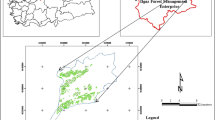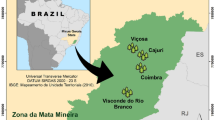Abstract
Artificial neural network models are a popular estimation tool for fitting nonlinear relationships because they require no assumptions about the form of the fitting function, non-Gaussian distributions, multicollinearity, outliers and noise in the data. The problems of back-propagation models using artificial neural networks include determination of the structure of the network and over-learning courses. According to data from 1981 to 2008 from 15 permanent sample plots on Dagangshan Mountain in Jiangxi Province, a back-propagation artificial neural network model (BPANN) and a support vector machine model (SVM) for basal area of Chinese fir (Cunninghamia lanceolata) plantations were constructed using four kinds of prediction factors, including stand age, site index, surviving stem numbers and quadratic mean diameters. Artificial intelligence methods, especially SVM, could be effective in describing stand basal area growth of Chinese fir under different growth conditions with higher simulation precision than traditional regression models. SVM and the Chapman–Richards nonlinear mixed-effects model had less systematic bias than the BPANN.









Similar content being viewed by others
References
Alkasassbeh M (2013) Predicting of surface ozone using artificial neural networks and support vector machines. Int J Adv Sci Technol 55:1–12
Ashraf MI, Zhao ZY, Bourque CPA, MacLean DA, Meng FR (2013) Integrating biophysical controls in forest growth and yield predictions with artificial intelligence technology. Can J For Res 43:1162–1171
Assmann E (1970) The principles of forest yield study: studies in the organic production, structure, increment and yield of forest stands. Pergamon Press, Oxford
Basheer IA, Hajmeer M (2000) Artificial neural networks: fundamentals, computing, design, and application. J Microbiol Methods 43(1):3–31
Bráulio PFC, Gilson FS, Daniel HBB, Adriano RM, Helio GL (2017) Descrição do perfil do tronco de árvores em plantios de diferentes espécies por meio de redes neurais artificiais. Braz J For Res 37(90):99–107
Chang CC, Lin CJ (2011) LIBSVM: a library for support vector machines. ACM Trans Intell Syst Technol (TIST) 2(3):389–396
Clutter J, Fortson J, Pienaar L, Brister G, Bailey R (1983) Timber management—a quantitative approach. Wiley, New York
Corne S, Carver S, Kunin W, Lennon J, Van Hees WWS (2004) Predicting forest attributes in southeast Alaska using artificial neural networks. For Sci 50(2):259–276
Dande P, Samant P (2018) Acquaintance to artificial neural networks and use of artificial intelligence as a diagnostic tool for tuberculosis: a review. Tuberculosis 108:1–9
Demuth H, Beale M (2009) User’s guide: neural network toolbox for use with Matlab. The Mathworks Inc, Natick, MA
Diamantopoulou MJ (2005) Artificial neural networks as an alternative tool in pine bark volume estimation. Comput Electron Agric 48(3):235–244
Diamantopoulou MJ, Milios E (2010) Modelling total volume of dominant pine trees in reforestations via multivariate analysis and artificial neural network models. Biosyst Eng 105(3):306–315
Egrioglu EC, Aladag AH, Günay S (2008) A new model selection strategy in artificial neural networks. Appl Math Comput 195(2):591–597
Foody GM, Boyd DS, Cutler MEJ (2003) Predictive relations of tropical forest biomass from Landsat TM data and their transferability between regions. Remote Sens Environ 85:463–474
Gadow VK, Hui GY (1999) Modelling forest development. Springer, Amsterdam
Gianfranco S, Laura M, David G (2007) Development of a neural network model to update forest distribution data for managed alpine stands. Ecol Model 206:331–346
Godarzi MS, Abbaspour RA, Ahadnezhad V, Khakbaz B (2012) Comparison of support vector machine, neural network, and maximum likehood methods for the separation of lithological units. Iran J Geol Summer 6(22):75–92
Gunn SR, Brown M, Bossley KM (1997) Network performance assessment for neurofuzzy data modelling. In: Liu X, Cohen P, Berthold M (eds) Intelligent data analysis, volume 1208 of Lecture Notes in Computer Science. Springer, Berlin
Harrell FE (2001) S-Plus software. In: Bickel P, Diggle P, Gather U, Zeger S (eds) Regression modelling strategies. Springer series in statistics. Springer, New York, NY
Henry M, Bombelli A, Trotta C, Alessandrini A, Birigazzi L, Sola G, Vieilledent G, Santenoise P, Longuetaud F, Valentini R, Picard N, Saint-André L (2013) GlobAllomeTree: international platform for tree allometric equations to support volume, biomass and carbon assessment. iFor Biogeosci For 6(1):1–5
Hong D (2012) Application of support vector machine in intrusion detection. Comput Eng 4:47
Jensen JR, Qiu F, Ji MH (1999) Predictive modelling of coniferous forest age using statistical and artificial neural network approaches applied to remote sensor data. Int J Remote Sens 20:2805–2822
Johnston M, Williamson T, Munson A, Ogden A, Moroni M, Parsons R, Price D, Stadt J (2010) Climate change and forest management in Canada: impacts, adaptive capacity and adaptation options. A State of Knowledge report. Sustainable Forest Management Network, Edmonton
Lamb SM, MacLean DA, Hennigar CR, Douglas G (2018) Pitt forecasting forest inventory using imputed tree lists for LiDAR grid cells and a tree-list growth model. Forests 9(4):167
Li XF, Tang SZ, Wang SL (1988) The establishment of variable density yield table for chinese fir plantation in dagangshan experiment bureau. For Res 1(4):382–389
Lippmann R (1987) An introduction to computing with neural nets. IEEE 4(2):4–22
Liu CM, Zhang SY (2005) Models for predicting product recovery using selected tree characteristics of black spruce. Can J For Res 35(4):930–937
Malinen J, Maltamo M, Verkasalo E (2003) Predicting the internal quality and value of Norway spruce trees by using two non-parametric nearest neighbor methods. For Prod J 53(4):85–94
Merriam RA, Phillips VD, Liu W (1995) Early diameter growth of trees in planted forest stands. For Ecol Manag 75(1–3):155–174
Mohammadi Z, Mohammadi LS, Lohmander P, Olsson L (2017) Estimation of a basal area growth model for individual trees in uneven-aged Caspian mixed species forests. J For Res. https://doi.org/10.1007/s11676-017-0556-7
Monserud RA, Sterba H (1996) A basal area increment model for individual trees growing in even- and uneven-aged forest stands in Austria. For Ecol Manag 80:57–80
Olden JD, Jackson DA (2002) Illuminating the “black box”: a randomization approach for understanding variable contributions in artificial neural networks. Ecol Model 1:135–150
Rumelhart D, Hinton G, Williams R (1986) Learning internal representations by error propagation: parallel distributed processing, vol 1: foundations. MIT Press, Cambridge
Rumelhart D, Durbin R, Golden R, Chauvin Y (1995) Backpropagation: the basic theory. Backpropagation: theory, architectures, and applications. Lawrence Erlbaum Associates, Hillsdale
Sapankevych N, Sankar R (2009) Time series prediction using support vector machines: a survey. Comput Intell Mag IEEE 2:24–38
Schroder J, Soalleiro RR, Alonsa GV (2002) An age independent basal area increment model for maritime pine trees in northwestern Spain. For Ecol Manag 157:55–64
Scrinzi G, Marzullo L, Galvagni D (2007) Development of a neural network model to update forest distribution data for managed alpine stands. Ecol Model 206(3–4):331–346
SFA (2013) Reports of Chinese forestry resource: the 8th national forest resource inventory. Chinese Forestry Publishing House, Beijing
Shapiro SS, Wilk MB (1965) An analysis of variance test for normality (complete samples). Biometrika 52:591–611
Sun HG, Zhang JG, Duan AG, Tong SZ (2007) Application of five types of logistic models imitating the stand basal area distribution of Chinese fir plantation. For Res 20(5):622–629
Swingler K (1996) Applying neural networks: a practical guide. Academic Press, London
Vapnik V (1995) The nature of statistical learning theory. Springer, NY
Vapnik V, Golowich SE, Smola A (1997) Support vector method for function approximation, regression estimation, and signal processing. MIT Press, Cambridge, MA
Wu DS, Ji YQ (2015) Dynamic estimation of forest volume based on multi-source data and neural network mode. J Agric Sci 7(3):18–31
Author information
Authors and Affiliations
Corresponding author
Additional information
Project funding: The work was supported by the National Scientific and Technological Task in China (Nos. 2015BAD09B0101, 2016YFD0600302), National Natural Science Foundation of China (No. 31570619), and the Special Science and Technology Innovation in Jiangxi Province (No. 201702).
The online version is available at http://www.springerlink.com
Corresponding editor: Tao Xu.
Rights and permissions
About this article
Cite this article
Che, S., Tan, X., Xiang, C. et al. Stand basal area modelling for Chinese fir plantations using an artificial neural network model. J. For. Res. 30, 1641–1649 (2019). https://doi.org/10.1007/s11676-018-0711-9
Received:
Accepted:
Published:
Issue Date:
DOI: https://doi.org/10.1007/s11676-018-0711-9




